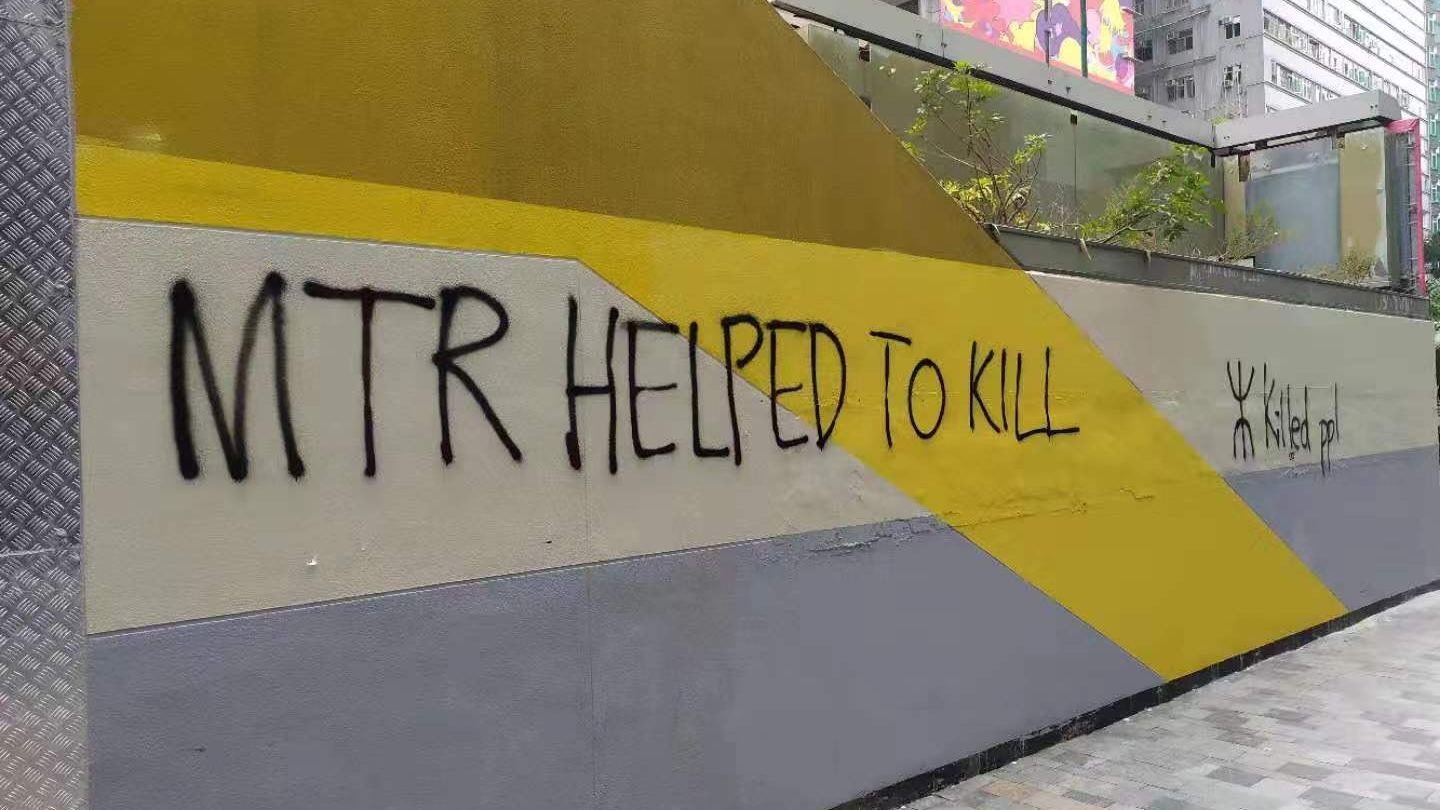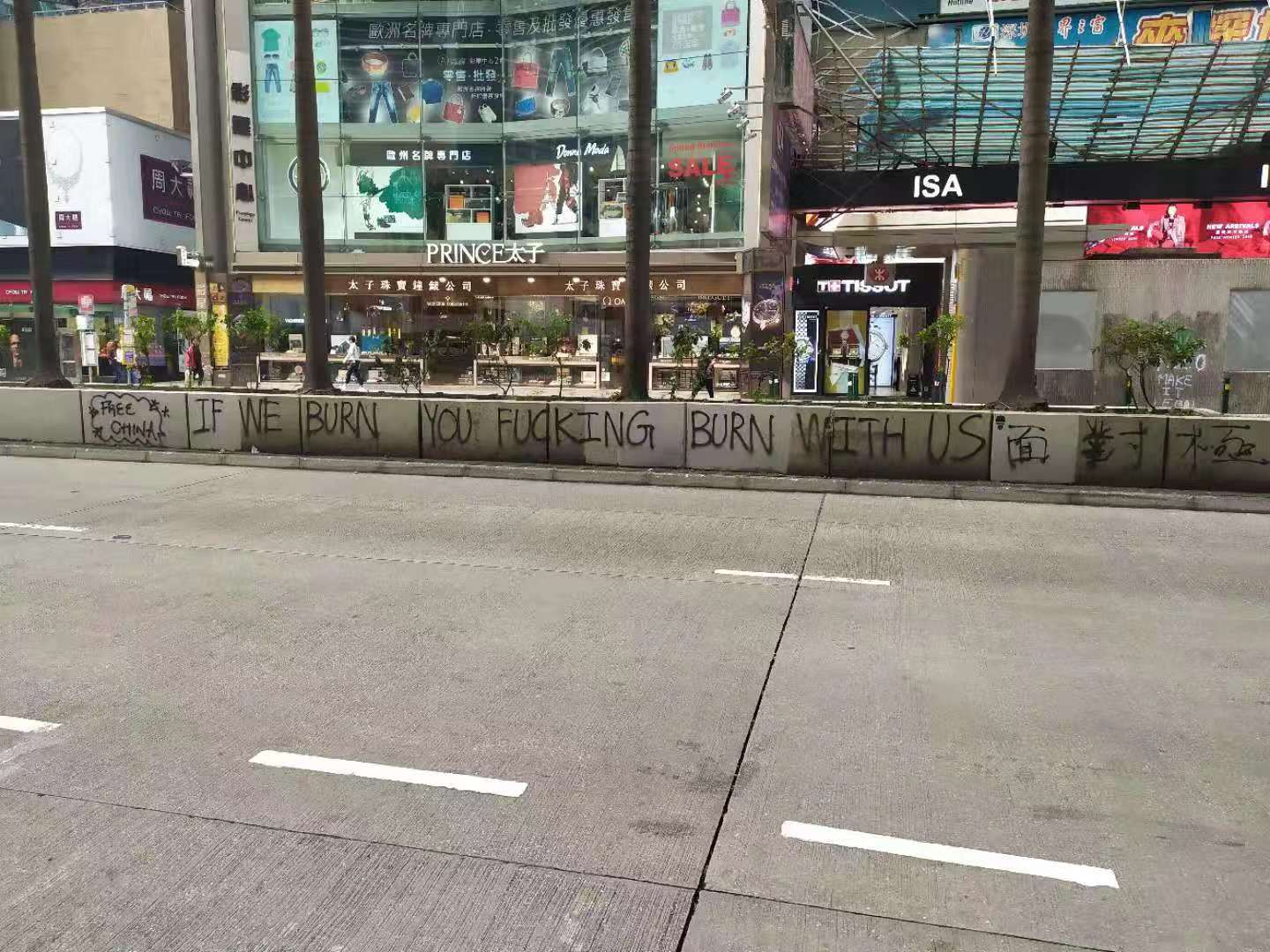
A painted slogan on the side of an MTR entrance in Hong Kong, November 25, 2019. /Photo by Tom Fowdy
A painted slogan on the side of an MTR entrance in Hong Kong, November 25, 2019. /Photo by Tom Fowdy
Editor's note: Tom Fowdy is a British political and international relations analyst and a graduate of Durham and Oxford universities. He writes on topics pertaining to China, the DPRK, Britain and the United States. The article reflects the author's opinions and not necessarily the views of CGTN.
On Tuesday morning, I explored Kowloon's Tsim Sha Tsui (TST), a famous district of Hong Kong that constitutes one of the city's dominant tourism and retail hot spots. A month or so ago, the city's central Nathan Road had been subjected to an extensive battle between the police and protesters. The scars still run deep in the area. Traffic lights had been pulled down and destroyed, swathes of brick paving had disappeared and been replaced with poured concrete, MTR stations, as usual, had been targeted, and graffiti slogans were spray-painted everywhere in English.
Slogans have been a common theme of the protests. Some of them are well-known and represent their demands, such as "fight for freedom, stand with Hong Kong," "five demands, not one less" and so on. Alternatively, other slogans aim to convey specific messages and narratives to gain mainstream and social media attention for their movement and public support.
However, in doing so, these "messages" reveal a fundamental flaw and problem with the broader movement: Not everything the protesters say is factual. Rather, many of these slogans clearly illustrate how activists are instead peddling mass hysteria, inaccurate claims and even total misinformation about given occurrences in the city. Their goal is to ferment further unrest and tolerance for their cause, and many locals seem to believe without giving them serious thought. This has long been a core of the movement's strategy and psychology, and it isn't given Western media coverage. The following is what I found.
To begin with, the protesters are repeatedly and falsely claiming that people are being killed in clashes with the police and authorities. A painted slogan on the side of an MTR entrance in TST claims that the mass transit network itself has killed people. "MTR Helped To Kill," it reads. But who exactly has died? Local authorities in responding to violence have not actually either directly or indirectly, killed any protesters. Yet we have a slogan that insists a subway system is killing people merely because it is allegedly aligned with authorities as part of the city's public transport infrastructure. This has led to the relentless destruction of MTR stations and their entrances throughout the city.

A slogan on the side of a street in Hong Kong, November 25, 2019. /Photo by Tom Fowdy
A slogan on the side of a street in Hong Kong, November 25, 2019. /Photo by Tom Fowdy
Next up, there were several hysterical slogans concerning the standoff at Hong Kong Polytechnic University against police. Again, fictitious claims of people being killed were invoked. The slogans claimed openly there was a massacre at the university. However, the situation has largely de-escalated with no causalities whatsoever. Another slogan in the area branded the police as "murderers" and "terrorists." Another one stated, albeit with added profanity, "If we burn, you burn with us." Yet, ironically, it was the protesters who set a man on fire, not the police.
What do we learn from this? In an earlier piece, I described "Hong Kong's mindset of mass hysteria," whereby protesters continually transcend facts, voicing exaggerated and over the top claims and inappropriately overreacting and playing the victim accordingly. These factually void slogans are representative of that sentiment, with constant rumors claiming that the police have kidnapped, killed and even sexually abused protesters being spread across social media.
From this, what should the outside observer be aware of? The protesters have had a great deal of near unconditional support from the Western mainstream media, who have not sought to offer any serious or reflective scrutiny of their behavior or claims, instead choosing to perpetuate their narrative favorably at all costs. However, when you look at the facts and observe things on the ground, you realize quite quickly that the protesters are not always accurate, or for that matter, honest.
Therefore, in summary, Hong Kong is suffering from a problem of misinformation in an induced climate of mass hysteria. Police brutality has been persistently exaggerated in numerous nonsensical ways, something many in the local population have been inclined to believe, rather than question with an open mind. However, telling the truth matters, and nothing can move forward in Hong Kong until people are prepared to seriously confront some of these ludicrous assumptions and stop giving a free pass to those deliberately peddling hysteria to further induce public unrest.
(If you want to contribute and have specific expertise, please contact us at opinions@cgtn.com.)